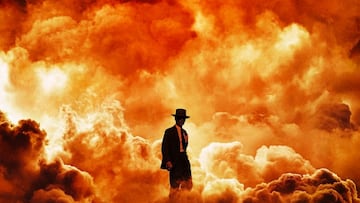ENTERTAINMENT
This was the nuclear explosion for ‘Oppenheimer’ that Nolan did without special effects
Starring Cillian Murphy, Emily Blunt and Matt Damon, ‘Oppenheimer’ will be released in theatres on Friday 21 July, the same day as ‘Barbie’.

Christopher Nolan has been nominated for five Oscars, five BAFTAs, six Golden Globes, was named by Time magazine as one of the 100 most influential people in the world and is generally considered to be one of the planet’s most loved movie directors. All that without being a fan of CGI (computer-generated imagery), which has become standard practice in the feature film industry in the last 65 years (Alfred Hitchcock’s Vertigo is the first to have used it in 1958).
Nolan: “CGI tends to feel safe”
Speaking to Empire for their July issue, Nolan revealed, “I find CG rarely is able to grab you. It tends to feel safe. Even if it’s impressive and beautiful, it’s difficult to make you feel danger”.
There are few things in life, you’d have to assume, that could make you feel danger more than a nuclear explosion, which just happens to be one of the most eye-catching scenes from Nolan’s Oppenheimer, set to be released theatrically on Friday 21 July (the same day as Greta Gerwig’s Barbie) and starring Cillian Murphy, Emily Blunt and Matt Damon.
As the name suggests, the movie tells the tale of Robert Oppenheimer, one of the pioneers of nuclear weapons during World War II, and has as part of its plot the Trinity Test, the world’s first-ever atomic explosion. Nolan couldn’t pull off a nuclear blast without CGI…or could he?
How Oppenheimer pulled off the Trinity Test
It turns out he could. To do so, the 52-year-old explained to Empire how he used one of the oldest tricks in the Hollywood book - forced perspective, an optical illusion which is used to make objects appear further away, closer, bigger or smaller than they actually are. In this case, Nolan and his team used scaled down models to create a small ‘blast’, which appears enormous due to the proximity of the camera.
“We don’t call them miniatures; we call them ‘big-atures,’” he said. “We do them as big as we possibly can, but we do reduce the scale so it’s manageable. It’s getting it closer to the camera, and doing it as big as you can in the environment”.
As for the pyrotechnics used to create the ‘blast’ itself, Nolan revealed that mainly a combination of gasoline and propane was used, while aluminium power and magnesium were then added to create the visual flashing effect that accompanies a nuclear explosion.
A real explosion, then, but no real danger. How well did Nolan and his crew pull it off? You don’t have long to wait to find out.






